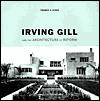Irving Gill, reconsidered
 Irving Gill, a pioneering modernist, would have celebrated his 130th birthday this year.
Irving Gill, a pioneering modernist, would have celebrated his 130th birthday this year. Had there been a party, Gill probably would have liked it to be held at the Hotel del Coronado, near downtown San Diego, where he often danced and romanced friends and clients who unwittingly helped him invent a revolutionary, elegantly stripped-down approach to architecture - in relative isolation. For sure, Gill would have wanted Thomas S. Hines, a University of California at Los Angeles professor of history and architecture, to be there.
Hines' engaging, richly illustrated new book "Irving Gill and the Architecture of Reform" may be the long-hoped-for vehicle that establishes the architect's place as an early 20th-century instigator of the modern movement.
Hines digs deeper than the respected Gill historians who came before him to document the chronology and relationship of remarkably similar, minimalist buildings designed within years of each other by Gill and Adolf Loos, a Vienna, Italy-based contemporary. (In architecture circles, Loos gets more credit as an innovator than Gill, a quirk of fate probably linked to Loos' angry 1908 manifesto, "Ornament and Crime," and his participation in the life of a European art capital.)
The two men never met, but Hines argues they could have encountered each others' work, moralistic writings and bias toward simple, "honest" forms in design publications that crossed the Atlantic. He also notes that Gill, and possibly Loos, would have known that in 1892 Chicago architect and ornamentalist extraordinaire Louis Sullivan called for a hiatus from lavishly ornamented building facades in favor of developing structure and its visual expression. At the time of Sullivan's writing, Gill was working for him at Adler & Sullivan and Loos visited Chicago to examine its new skyscraper architecture.
In 1893, Gill moved to San Diego. At first he worked in a style that blended Arts and Crafts simplicity and craftsmanship with the horizontal Prairie school associated with Frank Lloyd Wright. (Wright and Sullivan had supervised Gill's work at Adler & Sullivan.) The Marston house, which Gill designed with his first partner, William S. Hebbard, adjacent to Balboa Park, is a fine example now operated as a house museum by the San Diego Historical Society.
Hines pinpoints 1907 as a pivotal year for Gill, the year he committed to modernism's "less is more" credo and never looked back. It was also the year Gill engaged in a remarkable seven-month partnership with Frank Mead, another free-spirited San Diego architect.
Gill and Mead shared an attraction to earthy, geometrically potent Arab North African architecture, which Mead had sketched and photographed during his travels. More important, they both believed in a profound moral responsibility to improve the lives of others, especially workers and displaced Native Americans, through architecture.
Gill experimented with affordable cottage designs he built and rented out in San Diego, designed the new town of Torrance near Los Angeles for factory workers and their families, and designed a chapel and modest houses that residents of the Barona Indian Reservation built for themselves near Lakeside, Calif.
Hines pinpoints the 1907, radically Spartan-looking Allen house in Bonita, Calif., constructed entirely of concrete by the upstart partners, as the building that matched, or even anticipated, similar designs in Europe. Hines compares this bold project with contemporaneous advances in modern architecture by such luminaries as Charles Rennie Mackintosh of Scotland, Peter Behrens of Germany and Otto Wagner and Loos of Austria. (Happily, the Allen house was recently stripped of shutters added by a former owner and deplored by Hines in the book.)
Another key issue Hines pursues in lively fashion is the degree to which Gill was influenced by California mission architecture. In Gill's day and in retrospect, his vocabulary of elementary forms - the arch, the arcade, rectangular windows and recesses, flat roofs - and smooth concrete walls (a modern version of adobe) may have been too closely associated with historic, highly romanticized missions.
In a surprising revelation, Hines quotes the unpublished "second thoughts" of Esther McCoy, the late California architecture critic credited with starting a midcentury revival in interest in Gill's then-nearly forgotten work. Late in life, she feared an exaggerated interpretation of the mission influence on Gill had inadvertently relegated him to regional status, rather than his deserved place as a pathfinder in an international movement that remains powerful to this day.
Relying heavily on the delightfully candid memories of Gill's late nephew, architect Louis Gill, Hines paints a fond, if sketchy, portrait of a charming and righteous man. For more than 30 years, the author also has roamed Southern California to study and photograph Gill's buildings. He laments the demolition of 125 of Gill's designs - nearly half of the architect's roughly 300 built projects - and so should we. The Klauber house in San Diego, the Dodge house in West Hollywood and a school in Oceanside that was moved to Escondido for re-use are among the painful losses Hines cites.
Hines has gathered 300 or so photographs and drawings of Gill's work, producing a stunning, handsomely printed portfolio of buildings that still look fresh and inspire awe at Gill's boldness.
Tragically, many of these places now can only be experienced through books such as this one. With every page building to a tribute to Gill's considerable legacy, Hines makes a strong case and a forceful plea for preserving what remains of his ingenious architecture.
(c) Copley News Service
advertisement

Related Articles
Author: Ann Elizabeth Jarmusch
Archives
Funny Girl on Stage Tonight
Singing and Science in South Jersey
Visions From Around the World
All the Spring`s a Stage at CCC
An Entertaining Threat in SJ
Free Theatre Tickets for Young People
Free Theatre Tickets for Young People
Suzanne`s Diary for Nicholas
Hostage
The Final Season - Fathers, Sons and One Last Season in a Classic Ballpark
A Different Drummer
Glory Denied
The Cold Six Thousand
Poker: Bets, Bluffs and Bad Beats
A Primate`s Memoir
More Articles







